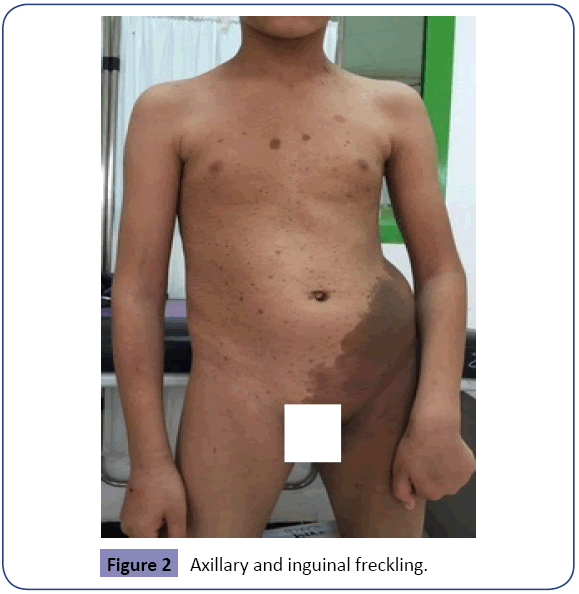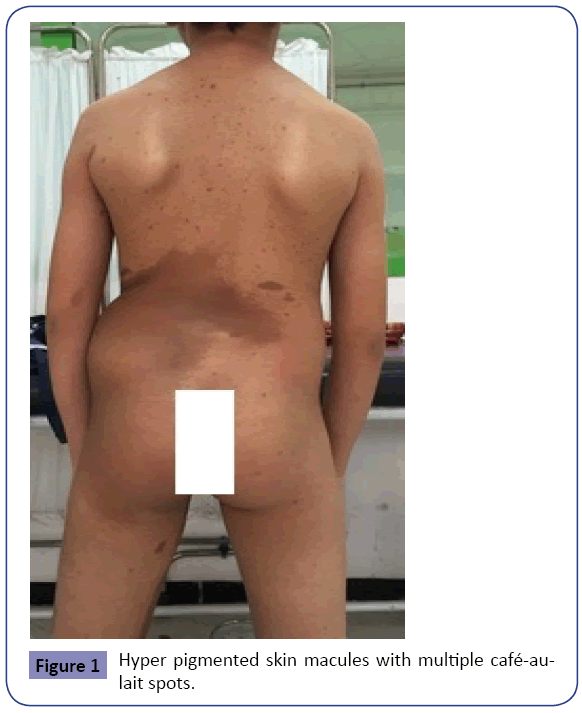Neurofibromatosis Type 1 (NF1): Case Report and Review of literature
Chouaib Sayah, Mahmoud Benmahmoud, Smain Ait Yahia and Zineddine Soualili
DOI10.4172/2472-1786.100028
University of Farhat Abbas, Women's and Children's Hospital, Setif, Algeria
- Corresponding Author:
- Chouaib Sayah
Departement of Pediatric Surgery
University of Farhat Abbas
Women's and Children's Hospital, Setif, Algeria 19000
Tel: +213773852781
E-mail: sayahchouaib@gmail.com
Received date: April 02, 2016; Accepted date: May 31, 2016; Published date: June 07, 2016
Citation: Sayah C, Benmahmoud M, Ait Yahia S, et al. Neurofibromatosis Type 1 (NF1): Case Report and Review of literature. J Child Dev Disord. 2016, 2:3.doi: 10.4172/2472-1786.100028
Abstract
Neurofibromatosis type 1 (NF1) or Von Recklinghausen's disease is a rare genetic disorder characterized by the development of multiple noncancerous (benign) tumors of nerves and skin (neurofibromas) and areas of abnormally decreased or increased coloration of the skin. We present a case of 11-year-old boy with NF-1. The disease started in childhood with the appearance of multiple hyper pigmented skin macules. The boy presents excruciating lower back pain and lumbar scoliosis. The diagnosis NF-1 was made according to the presence of two or more diagnostic criteria of the National Institute of Health Consensus Development Conference. NF1 is a multisystem disorder requiring management by multiple disciplines, often coordinated through a primary care physician or a geneticist and dermatologist.
Introduction
Neurofibromatosis type 1 (NF1) or Von Recklinghausen's disease is a rare genetic disorder characterized by the development of multiple noncancerous (benign) tumors of nerves and skin (neurofibromas) and areas of abnormally decreased or increased coloration of the skin. The earliest historical evidence first appeared in the 13th Century, but it was not until Friedrich Daniel von Recklinghausen published his landmark paper in 1882 [1]. Beginning in early childhood, patients with neurofibromatosis type 1 have multiple café-au-lait spots, which are flat patches on the skin that are darker than the surrounding area. These spots increase in size and number as the individual grows older. Freckles in the underarms and groin typically develop later in childhood.
Case Report
History
An 11-year-old boy is referred to our pediatric surgery department. The disease started in childhood with the appearance of multiple hyper pigmented skin macules. The boy presents excruciating lower back pain and lumbar scoliosis.
Physical examination
Dermatological status: Hundreds of hyper pigmented skin macules on the chest and back; multiple café-au-lait spots with diameter >1.5 cm (Figure 1); axillary and inguinal freckling (Figure 2). The mucous membranes were not affected.
Ophthalmological Status
Lisch’s nodules on the iris of both eyes were without clinical visual involvement.
Lab and imaging studies, histologic findings and consultations
The standard laboratory tests values were in the Normal range. X-ray photography was within the normal too. CT scan of spine and lumbar region: Lumbar scoliosis with an abscess of the left psoas, brain MRI without anomalies. Lumbar MRI: Neurofibroma left psoas muscle, with multidirectional extension with lumbar scoliosis and mega dural sheath. The neurologist did not detect alterations in the Central and peripheral nervous system. According to the otologist the acoustic nerve has not been damaged. The histological result confirmed the diagnosis of Neurofibromatosis (Psoas biopsy).
Diagnosis
The diagnosis NF-1 was made according to the presence of two or more diagnostic criteria of the National Institute of Health Consensus Development Conference (Table 1) [2]:
| Clinical diagnostic criteria for neurofibromatosis-1 (NF1) |
|---|
Patients have two or more of the following symptoms:
|
Table 1: Diagnostic criteria of the National Institute of Health Consensus Development Conference.
a) Six or more café-au-lait spots measuring at least 5 mm before puberty or 15 mm after puberty.
b) Axillary or inguinal freckling.
c) Two or more Lisch’s nodule.
Discussion
The symptoms of neurofibromatosis have been observed for a long time before Robert William Smith described it in 1849 [3]. The classic variety is the one which German pathologist, Friedrich Daniel von Recklinghausen reported, who precisely described the diverse findings as a single entity in 1882; so the condition is often directed to as von Recklinghausen’s disease. Von Recklinghausen’s neurofibromatosis (NF-1) is inherited in an autosomal-dominant fashion and has a prevalence of between 1 per 3000 and 1 per 5000 live births thus being one of the most common autosomal-dominant conditions in humans [4].
In childhood or early adolescence, the characteristic clinical features would be apparent. NF-1 which is the most common type accounts for 90% of cases and is characterized by multiple café-au-lait spots and the incidence of neurofibromas along peripheral nerves [5]. Café-au-lait discoloration generally emerge before the development of neurofibromas and their amounts increase with age [6]. Cutaneous neurofibromas are soft, fleshy -pink colored tumors, most enormous on the trunk and limbs as sessile or dome-shaped masses, other clinical aspects contain Lisch’s nodules (melanocytic pigmented iris hamartomas) and oral lesions.
Neurofibromatosis type 1 (NF1) represents a major risk factor for development of malignancy, particularly malignant peripheral nerve sheath tumors, optic gliomas, other gliomas, and leukemias, malignancy is an important component of the NF1 phenotype, and one of the few life-threatening complications [7].
Most children with NF1 followed a regular education, over one third of patients needed support, such as language therapy, extra-curricular educational support, or psychological support, Most parents reported learning difficulties, writing problems, and attention difficulties. Learning difficulties are the main concern of parents, and are generally present in 50% of cases [8]. There is a comorbidity of motor and cognitive deficit in developmental disorders. The principal complication during childhood is learning disabilities [8].
Predominance of visuospatial and motor difficulties in children with NF should be considered in rehabilitation programs aiming to reduce the learning and school difficulties of these children. Parental reports of specific difficulties should be considered independently of clinical severity and neuropsychological tests [9].
The patient, presented here, was referred to compatible center for specialized care (Cincinnati Neurofibromatosis Center). He did not respond to our calls for following up his treatment procedure.
Conclusion
NF1 is a multisystem disorder requiring management by multiple disciplines, often coordinated through a primary care physician or a geneticist. The dermatologist has a role not only in the diagnosis of NF1 and differentiating it from other similar disorders but also in the recognition of rare but associated skin manifestations. There is a paucity of available medical treatments, but ongoing trials hold promise in treating both the cutaneous and noncutaneous manifestations of NF1.
Conflict of Interest
There is no conflict of interest among the authors.
Funding Statement
There is no funding for the case report.
Ethical Approval
Necessary approval was taken from the Institution and the patients for carrying out this work.
References
- Paine RS (1956) A clinical, pathological and genetic study of multiple neurofibromatosis. American Journal of Human Genetics 8: 190.
- Neurofibromatosis (1987) NIH Consens Statement Online 6:1e19
- Kobrin JL, Blodi FC, Weingeist TA (1979) Ocular and orbital manifestations of neurofibromatosis.SurvOphthalmol 24: 45-51.
- Boyd KP, Korf BR, Theos A (2009) Neurofibromatosis type 1. Journal of the American Academy of Dermatology 61: 1-4.
- Dimitrova V, Yordanova I, Pavlova V, Valtchev V (2008) A case of neurofibromatosis type 1. J of IMAB 1: 63-67.
- White AK, Smith RJ, Bigler CR, Brooke WF, Schauer PR, et al. (1986) Head and neck manifestations of neurofibromatosis. Laryngoscope 96: 732-737.
- Korf BR (2000) Malignancy in neurofibromatosis type 1. The oncologist 5: 477-485.
- Hyman SL, Shores EA, North KN (2006) Learning disabilities in children with neurofibromatosis type 1: Subtypes, cognitive profile, and attentiondeficit-hyperactivity disorder. Developmental Med Child Neurol 48: 973-977.
- Coutinho V, Kemlin I, Dorison N, BilletteDVT, Rodriguez D, et al. (2016) Neuropsychological evaluation and parental assessment of behavioral and motor difficulties in children with neurofibromatosis type 1. Res Develop Disabilities 48: 220-230.
Open Access Journals
- Aquaculture & Veterinary Science
- Chemistry & Chemical Sciences
- Clinical Sciences
- Engineering
- General Science
- Genetics & Molecular Biology
- Health Care & Nursing
- Immunology & Microbiology
- Materials Science
- Mathematics & Physics
- Medical Sciences
- Neurology & Psychiatry
- Oncology & Cancer Science
- Pharmaceutical Sciences


